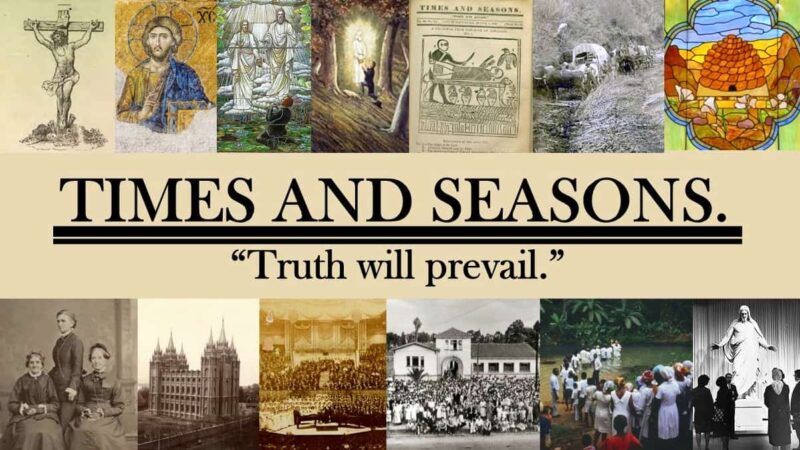The recently-published book Seven Visions: Images of Christ in the Doctrine and Covenants by Adam S. Miller and Rosalynde F. Welch is a fantastic opportunity to listen in on a conversation between two brilliant theological minds as they explore seven different sections of the Doctrine and Covenants with a Christological focus. The book is structured as a series of letters back and forth between the two authors, discussing the seven sections in question (19, 45, 76, 88, 110, 130, and 138). It was a delightful blend of heartfelt discussion, analysis of text, and conclusions that could sometimes be a surprising take on a familiar text.
It was enjoyable to see what suggestions Rosalynde and Adam had for interpretation of the revelations and visions. For example, in section 19, Rosalynde discusses the meaning of “shrink” in the phrase “Which suffering caused myself, even God, the greatest of all, to tremble because of pain, and to bleed at every pore, and to suffer both body and spirit—and would that I might not drink the bitter cup, and shrink” (D&C 19:18). She notes that while it is possible that this “refers to his innate human desire to ‘shrink away’ from pain and suffering,” there is another interpretation that offers its own theological richness. “Is ‘shrink’ here bundled with ‘drink the bitter cup’ as something that Christ is tempted not to do? … If this is the proper parsing of the grammar, it seems shrinking is equivalent to drinking the bitter cup, not its opposite. It is a shrinking of his own will, his own human instinct for self-preservation” (28). It’s a fascinating interpretation of the revelation – that Jesus was tempted to put himself first, but allowed that self-centered instinct to shrink in the face of God’s will.
Another of my favorite parts was Adam Miller’s analysis of the relationship between time and eternity in the Doctrine and Covenants. While traditional Christian thought places God outside of time and space (as both are creations of God), thus creating a dichotomy between eternity (the mode of existence that God experiences) and time (the mortal experience within the universe), Latter-day Saint theology is more open to God existing within the universe. Noting that the same sociality exists in the hereafter, “a relationship must involve interaction” and those interactions require “choices, actions, and consequences”, it means that “in this world, all relationships – that is, sociality itself – are about time. They’re made of time. They require time. Only time’s persistent flow can make actions and consequences, and thus marriages and families real and possible” (110). Because of this, “I don’t have the faintest idea what this … would mean without the ongoing reality of time, action, and consequence” and it seems likely that “eternal glory doesn’t stop time or supplant time or allow us to escape time. Rather, eternity shelters and blesses it” (113, 115). While I can only summarize brief snippets of the discussion here, it was the rich, thought-provoking analysis of time that I expected in Philip Barlow’s entry in the Themes in the Doctrine and Covenants and was surprised to find missing there.
While my own interest in theology and esoterica drew me to these two points as highlights of the experience of reading the book, there is a lot of beautiful and touching insight into experiencing and developing a relationship with Christ that could also be highlighted. For example, the concept of indwelling was a recurring theme – both Christ’s indwelling with God and our own indwelling with Christ. There is both brilliant analysis and a plethora of great quotes on this type of subject. For example, Rosalynde Welch wrote that when seeking Jesus, “the trick is not just to see, but to see and perceive” (78). In another place, she expresses gratitude for the future-facing focus of preparation in the Doctrine and Covenants, the “insistent not yet.” “I need it to cut through the complacency and self-congratulation I’m often tempted to wallow in. I need it to shake me free from a false life of ceaseless scrabbling for ever greater degrees of convenience and consumption. I am looking for degrees of glory, not degrees of comfort” (p. 82). And later again, “any approach to scripture, whether literal or literary, is faithful only to the extent that it ends by remaking me in the image of God that I encounter in its pages – not the other way round” (101).
Thus, there is a lot to love in Seven Visions: Images of Christ in the Doctrine and Covenants by Adam S. Miller and Rosalynde F. Welch, both for those seeking devotional reflection on the scriptures and those seeking stimulating theological discussion.

Comments
2 responses to “A Review: Seven Visions: Images of Christ in the Doctrine and Covenants”
Sounds like a real feast!
Thanks Chad, but where to from here, read the book, assess its claims, but where is the discussion? For example Adam’s definition of time which also plays out in Original Grace seems to close off the possibility that Eternal Life is possibly other dimensional – it appears to overlook the fact that death is all around when one steps off the planet or any cosmic body in the ‘known’ universe, the place you are depicting as a ‘theological’ home of the LDS.
I think Adam is on the right track when he says ‘I don’t have the faintest idea what this … would mean …’, nevertheless, he presses on to frame a meaning, which is fine if one acknowledges its limits –
I enjoy Roslynde and Adam’s writings, more probably for the literary touches.
Thanks for the review – I wouldn’t have known of this publication if you hadn’t posted. One thing: I note you find Philip Barlow’s effort lacking something you expected, what did you find missing in ‘Seven Visions’?